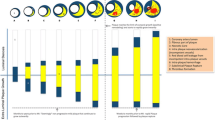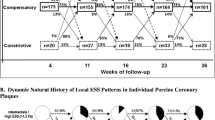Abstract
The first study to look at the flow of fluids through tubular structures was published by Jean Leonard Marie Poiseuille in 1840.1 He described what became the basic model of blood flow.
Access this chapter
Tax calculation will be finalised at checkout
Purchases are for personal use only
Preview
Unable to display preview. Download preview PDF.
Similar content being viewed by others
References
Poiseuille JLM. Recherches experimentales sur le mouvement des liquides dans les tubes de tres petits diametres. Comptes Rendus Academy of Science (Paris). 1840;2:961–1041.
Gregg DE, Green HD, Wiggers CL. Phasic variations in peripheral coronary resistance and their determinants. Am J Physiol. 1935;112:362–373.
Mann FC, Herrick JF, Essex HE, et al. The effect on the blood flow of decreasing the lumen of a blood vessel. Am J Physiol. 1938;4:249–252.
Gregg DE, Green HD. Phasic blood flow in coronary arteries obtained by a new differential manometer method. Am J Physiol. 1939;41:597–598.
Shipley RE, Gregg DE, Schroeder EF. An experimental study of flow patterns in various peripheral arteries. Am J Physiol. 1942;138:718–730.
Pritchard WH, Gregg DE, Shipley RE, et al. A study of flow and pattern responses in peripheral arteries to the injection of vasomotor drugs. Am J Physiol. 1942;138:731–740.
Shipley RE, Gregg DE. The effect of external constriction of a blood vessel on blood flow. Am J Physiol. 1944;141:289–296.
May AG, DeWeese JA, Rob CG. Hemodynamic effects of arterial stenosis. Surgery. 1963;53:513–524.
May AG, DeBerg LV, DeWeese JA, et al. Critical arterial stenosis. Surgery. 1963;54:250–259.
Fiddian RV, Byar D, Edwards EA. Factors affecting flow through a stenosed vessel. Arch Surg. 1964;88:83–90.
Berguer R, Hwang NHC. Critical arterial stenosis: a theoretical and experimental solution. Ann Surg. 1974;180:39–50.
Fleming RM, Harrington GM, Gibbs H, et al. Quantitative coronary arteriography and its assessment of atherosclerosis, I: examining the independent variables. Angiology. 1994;45:829–833.
Fleming RM, Harrington GM: Quantitative coronary arteriography and its assessment of atherosclerosis, II: calculating stenosis flow reserve from percent diameter stenosis. Angiology. 1994;45:835–840.
Gould KL, Lipscomb K, Hamilton GW. Physiologic basis for assessing critical coronary stenosis. Am J Cardiol. 1974;33:87–93.
Gould, Kirkeeide RL, Buchi M. Coronary flow reserve as a physiologic measure of stenosis severity. J Am Coll Cardiol. 1990;15:459–474.
Kirkeeide RL. Coronary obstructions, morphology and physiologic significance. In: Reiber JHC, Serruys PW, eds. Quantitative Coronary Arteriography. Dordrecht, The Netherlands: Kluwer Academic Publishers; 1991:229–244.
Brown BG. Response of normal and diseased epicardial coronary arteries to vasoactive drugs: quantitative arteriographic studies. Am J Cardiol. 1985;56:23E–29E.
Fleming RM, Kirkeeide RL, Smalling RW, et al. Patterns in visual interpretation of coronary arteriograms as detected by quantitative coronary arteriography. J Am Coll Cardiol. 1991;18:945–951.
Fleming RM, Fleming DM, Gaede R. Training physicians and health care providers to accurately read coronary arteriograms. A training program. Angiology. 1996;47:349–359.
Fleming RM, Kirkeeide RL, Taegtmeyer H, et al. Comparison of technetium-99m teboroxime tomography with automated quantitative coronary arteriography and thallium-201 tomographic imaging. J Am Coll Cardiol. 1991;17:1297–1302.
Fleming RM. Improving our interpretation of true percent diameter stenosis and stenosis flow reserve from visually reported percent diameter stenosis obtained at the time of cardiac catheterization. Int J Angiol. Submitted.
Fleming RM. The importance of physiologic information from cardiac PET in assessing coronary artery disease in people with “normal” coronary angiograms. Int J Angiol. Submitted.
Editor information
Editors and Affiliations
Rights and permissions
Copyright information
© 2000 Springer Science+Business Media New York
About this chapter
Cite this chapter
Fleming, R.M. (2000). Atherosclerosis: Understanding the Relationship Between Coronary Artery Disease and Stenosis Flow Reserve. In: Chang, J.B. (eds) Textbook of Angiology. Springer, New York, NY. https://doi.org/10.1007/978-1-4612-1190-7_29
Download citation
DOI: https://doi.org/10.1007/978-1-4612-1190-7_29
Publisher Name: Springer, New York, NY
Print ISBN: 978-1-4612-7039-3
Online ISBN: 978-1-4612-1190-7
eBook Packages: Springer Book Archive




